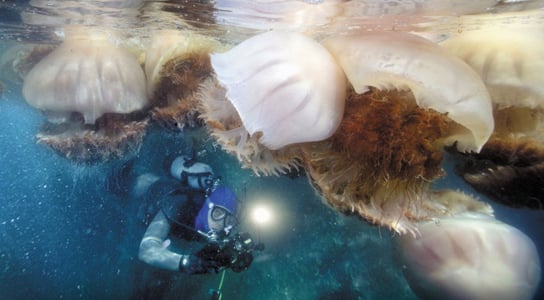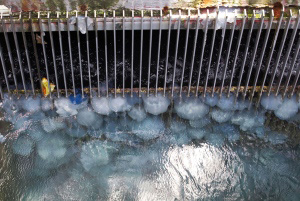
A marine scientist found a significant increase in jellyfish numbers from 1985 to 1997 and suggests that human-induced changes in their ecosystem could be the cause.
Last year, surfers were surprised at the amount of stinging moon jellyfish, some of which reached the size of bicycle wheels, which washed towards shore in Florida. The swarms of blobs grew so quickly that they forced a Florida nuclear plant to shut down temporarily because operators were concerned that the jellies would clog its water-intake pipes.
Earlier in 2011, there were similar invasions in Israel, Scotland and Japan. The giant Nomuar’s jellyfish (Nemopilema nomurai), that’s found in Japanese waters, can weigh up to 200 kg (440 lb) and has plagued the region in recent years, hampering fishing crews and causing a boat to capsize. Jellyfish have attacked stock fish farms in Tunisia and Israel.
 Scientists think that the jellyfish blooms are a warning and are due to the human impact upon marine ecosystems. This has caused a massive increase in jellyfish populations worldwide. A group of researchers published preliminary results on a comprehensive review of all jellyfish populations. There isn’t yet enough evidence to support the claims of a global upswing, but there are indications that there are problems.
Scientists think that the jellyfish blooms are a warning and are due to the human impact upon marine ecosystems. This has caused a massive increase in jellyfish populations worldwide. A group of researchers published preliminary results on a comprehensive review of all jellyfish populations. There isn’t yet enough evidence to support the claims of a global upswing, but there are indications that there are problems.
Jellyfish aren’t easy to study and have received little attention from marine biologists. The creatures could serve as one of the key indicators for the health of the oceans, which is why scientists want to build up a database and track their population.
Monty Graham, chairman of the Department of Marine Science at the University of Southern Mississippi in Diamondhead, discovered that from 1985 to 1997, jellyfish have grown substantially in number, and he has suggested that human changes in their ecosystem might be the root cause.
In the Bering Sea, jelly numbers have also risen throughout the 1990s. This indicates a shift in the oceans ecosystems, reducing the number of large fish and promoting populations of organisms from lower down the food chain. Algae, toxic plankton, and jellyfish are among the beneficiaries.
Nutrient pollution increases the food supply for jellyfish, overfishing can reduce their competition, and warmer temperatures are thought to trigger reproduction in some jellyfish species.
Long-term research in Japan indicates that jellyfish blooms happen only every 40 years, but since 2000, they have come yearly. The blooms seem to originate in Chinese water, where overfishing is prevalent.









Be the first to comment on "Jellyfish Bloom in Marine Ecologies As Ocean Health Declines"